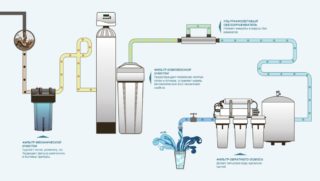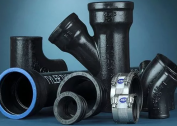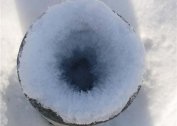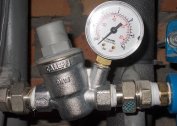The choice of equipment for cold and hot water supply systems is an important stage in the arrangement of an apartment or house. The higher the quality of all elements of the system, the less problems there will be in its operation.
Types of water supply systems

The complete set of plumbing and equipment for water supply depends on the type of water distribution. Water supply, as well as drainage, can be centralized and autonomous. The first type is usually implemented in urban environments. Water is supplied from a single source, and the discharge is sent to a common collector. The advantages of this organization of water supply and drainage is that all the problems in the outer part of the mains are solved by utilities.
Private houses are equipped with autonomous systems if connection to the citywide network is impossible. This type of water supply requires a well or well. Homeowners are independent of problems outside their property, emergency or seasonal outages. But the support of autonomous highways is entirely their concern.
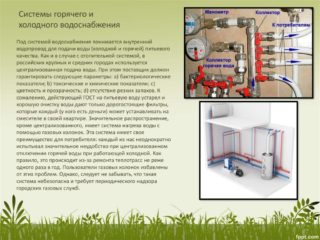 When selecting domestic equipment for water supply, one must also take into account the method of connecting branches to consumers. Piping can be:
When selecting domestic equipment for water supply, one must also take into account the method of connecting branches to consumers. Piping can be:
- consistent;
- collector;
- mixed.
In the first case, the engineering lines run in parallel, connecting via tees. The advantage of this wiring is the ease of installation and efficiency, and the disadvantage is the dependence on the pressure of the water stream. With a large number of consumers, water may not be enough.
The collector option involves a fan pipe layout, which allows you to use all the plumbing equipment at the same time, since the pressure in the pipes will be constant. Each conclusion can independently overlap, without affecting the work of other consumers.
Collector wiring is more convenient, but more difficult to install and not economical. Accessories for fan water supply need more. In addition to additional pipes and fittings, special devices will be needed - collectors having a different number of connectors for connecting distribution pipes. It is more rational to create a mixed scheme combining both types of water supply.
Types of equipment and components
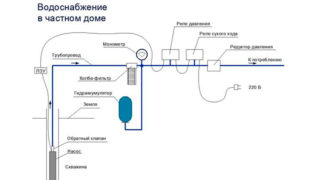 In the intra-house part of the pipelines, the elements are almost identical for both water supply systems. You will need pipes, connecting and diverting fittings and manifolds for fan water distribution. The exterior of the centralized system is managed by the public utilities.
In the intra-house part of the pipelines, the elements are almost identical for both water supply systems. You will need pipes, connecting and diverting fittings and manifolds for fan water distribution. The exterior of the centralized system is managed by the public utilities.
An external water supply network in private homes will require the following equipment:
- Pumping devices - surface or submersible. The first pump water from the intake hose. They are not able to lift water to a great height. Submersible pumps are more practical. They fall into the water, while cooling themselves. They are able to raise the fluid to the desired height, so it is better suited for wells. The downside is that submersible devices are more expensive. The pumps are connected to the outlet pipe and are equipped with check valves.
- Pipe sections. They can be steel, plastic, metal-plastic and copper. Most often, the second and third options are used. Steel products rust quickly and are heavy; copper is too expensive. Metal-plastic and plastic products weigh little, they are convenient to transport and install. They have a long service life. Pipes are connected at the expense of special connecting fittings.Connection to plumbing fixtures can be done with a flexible bellows connection for water.
- Hydraulic tank. The tank is used as a buffer tank for water supply and as a device for maintaining a stable pressure in the water supply network. Protects the pump from wear, protects the system from water hammer. The device is divided by a membrane partition into air and water compartments, and works due to the difference in pressure between them.
To provide a private house with hot water, water heating plants are used. They can be powered by gas or power. The most commonly used storage and flow heaters. In the first case, the device heats water according to the principle of a giant teapot. In the second, heating is performed at the moment the crane is turned on.
It is also desirable to equip the pumping unit with an automatic control unit. This will save time on maintenance and avoid emergency situations.
Automation should have the following functions:
- the ability to switch control to manual mode;
- switching the pumping station to the rise of water and drainage;
- protection against thermal overload of the engine;
- monitoring the water level and pressure switches;
- dry run protection.
The connection of automatic units should be entrusted to a specialist. The owner of the well or well will be able to control all water supply processes, including the pressure level.
All water mains are equipped with filtering devices. Which filter to install depends on the results of the water analysis. If rust removal is required, cartridge deferrizers or membrane filtration devices are used. At the same time, they are able to remove the smell of hydrogen sulfide and manganese compounds. The reverse osmosis device will save from excessive fluorination. If it is necessary to reduce rigidity, softener filters are used. When using well water, it is recommended to use an ultraviolet disinfectant.
For a more thorough cleaning, whole complexes are established that deferrizate and soften the water, remove any bacteria and harmful substances.
Key selection criteria
The selection of equipment for water supply begins with the choice of a pumping device. First of all, they rely on the depth of the rise. Here pay attention to the water pressure, the performance of the apparatus, the cross section of the pipes, the number of storeys of the building.
In conditions of autonomous water supply, it will be necessary to equip a coarse mesh filter and, in addition, a cartridge or membrane device. For a centralized system, only a cartridge device may be sufficient.
When buying a tank, pay attention to its volume and mount - horizontally and vertically. The larger the tank, the more benefit it will bring. However, the figures should correspond to the pump power. Material is also important. Steel tanks are more reliable since plastic is prone to deformation.
When choosing pipes, they are guided by the material of manufacture and the section of the products. According to state standards, products with a diameter of 32 mm and more are suitable for external work, from 12.7 mm for internal work. When drawing up a project, the necessary number of shaped products is calculated. All fittings and valves must exactly match the cross-section and principle of connection with the corresponding pipe sections.
If you choose everything correctly for sewage and water supply, problems in the operation of systems can be avoided. This will save the owner of the house nerves and save money due to the lack of need for repair.
